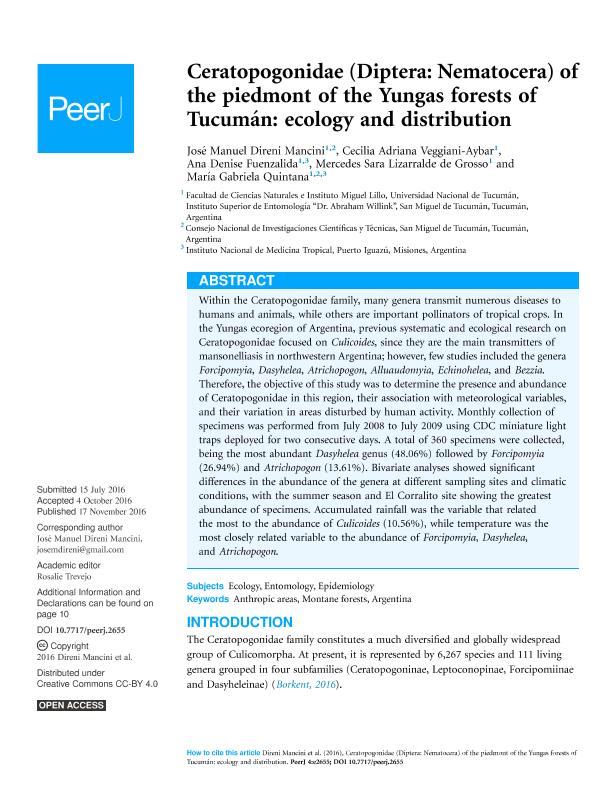Mostrar el registro sencillo del ítem
dc.contributor.author
Direni Mancini, José Manuel

dc.contributor.author
Veggiani Aybar, Cecilia Adriana

dc.contributor.author
Fuenzalida, Ana Denise

dc.contributor.author
Lizarralde de Grosso, Mercedes Sara
dc.contributor.author
Quintana, María Gabriela

dc.date.available
2019-11-26T16:46:39Z
dc.date.issued
2016-11
dc.identifier.citation
Direni Mancini, José Manuel; Veggiani Aybar, Cecilia Adriana; Fuenzalida, Ana Denise; Lizarralde de Grosso, Mercedes Sara; Quintana, María Gabriela; Ceratopogonidae (Diptera: Nematocera) of the piedmont of the Yungas forests of Tucumán: ecology and distribution; PeerJ Inc.; PeerJ; 4; e2655; 11-2016; 1-14
dc.identifier.issn
2167-8359
dc.identifier.uri
http://hdl.handle.net/11336/90495
dc.description.abstract
Within the Ceratopogonidae family, many genera transmit numerous diseases tohumans and animals, while others are important pollinators of tropical crops. Inthe Yungas ecoregion of Argentina, previous systematic and ecological research onCeratopogonidae focused onCulicoides, since they are the main transmitters ofmansonelliasis in northwestern Argentina; however, few studies included the generaForcipomyia, Dasyhelea, Atrichopogon, Alluaudomyia, Echinohelea, and Bezzia.Therefore, the objective of this study was to determine the presence and abundanceof Ceratopogonidae in this region, their association with meteorological variables,and their variation in areas disturbed by human activity. Monthly collection ofspecimens was performed from July 2008 to July 2009 using CDC miniature lighttraps deployed for two consecutive days. A total of 360 specimens were collected,being the most abundantDasyheleagenus (48.06%) followed byForcipomyia(26.94%) andAtrichopogon(13.61%). Bivariate analyses showed significantdifferences in the abundance of the genera at different sampling sites and climaticconditions, with the summer season and El Corralito site showing the greatestabundance of specimens. Accumulated rainfall was the variable that relatedthe most to the abundance of Culicoides(10.56%), while temperature was themost closely related variable to the abundance ofForcipomyia, Dasyhelea,andAtrichopogon.
dc.format
application/pdf
dc.language.iso
eng
dc.publisher
PeerJ Inc.
dc.rights
info:eu-repo/semantics/openAccess
dc.rights.uri
https://creativecommons.org/licenses/by-nc-sa/2.5/ar/
dc.subject
Anthropic areas
dc.subject
Montane forests
dc.subject
Argentina
dc.subject.classification
Zoología, Ornitología, Entomología, Etología

dc.subject.classification
Ciencias Biológicas

dc.subject.classification
CIENCIAS NATURALES Y EXACTAS

dc.title
Ceratopogonidae (Diptera: Nematocera) of the piedmont of the Yungas forests of Tucumán: ecology and distribution
dc.type
info:eu-repo/semantics/article
dc.type
info:ar-repo/semantics/artículo
dc.type
info:eu-repo/semantics/publishedVersion
dc.date.updated
2019-11-25T19:05:06Z
dc.journal.volume
4
dc.journal.number
e2655
dc.journal.pagination
1-14
dc.journal.pais
Estados Unidos

dc.journal.ciudad
San Diego
dc.description.fil
Fil: Direni Mancini, José Manuel. Universidad Nacional de Tucumán. Facultad de Ciencias Naturales e Instituto Miguel Lillo. Instituto Superior de Entomología; Argentina. Consejo Nacional de Investigaciones Científicas y Técnicas. Centro Científico Tecnológico Conicet - Tucumán; Argentina
dc.description.fil
Fil: Veggiani Aybar, Cecilia Adriana. Universidad Nacional de Tucumán. Facultad de Ciencias Naturales e Instituto Miguel Lillo. Instituto Superior de Entomología; Argentina. Consejo Nacional de Investigaciones Científicas y Técnicas. Centro Científico Tecnológico - Tucumán. Unidad Ejecutora Lillo; Argentina
dc.description.fil
Fil: Fuenzalida, Ana Denise. Ministerio de Salud. Instituto Nacional de Medicina Tropical; Argentina
dc.description.fil
Fil: Lizarralde de Grosso, Mercedes Sara. Universidad Nacional de Tucumán. Facultad de Ciencias Naturales e Instituto Miguel Lillo. Instituto Superior de Entomología; Argentina
dc.description.fil
Fil: Quintana, María Gabriela. Ministerio de Salud. Instituto Nacional de Medicina Tropical; Argentina. Consejo Nacional de Investigaciones Científicas y Técnicas. Centro Científico Tecnológico - Tucumán. Unidad Ejecutora Lillo; Argentina
dc.journal.title
PeerJ
dc.relation.alternativeid
info:eu-repo/semantics/altIdentifier/url/https://peerj.com/articles/2655/
dc.relation.alternativeid
info:eu-repo/semantics/altIdentifier/doi/https://dx.doi.org/10.7717/peerj.2655
Archivos asociados
